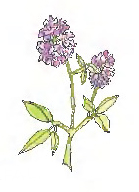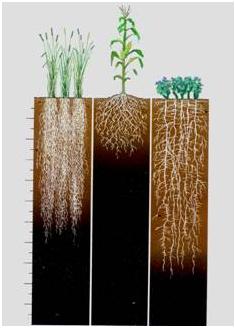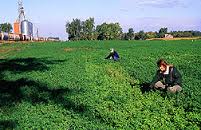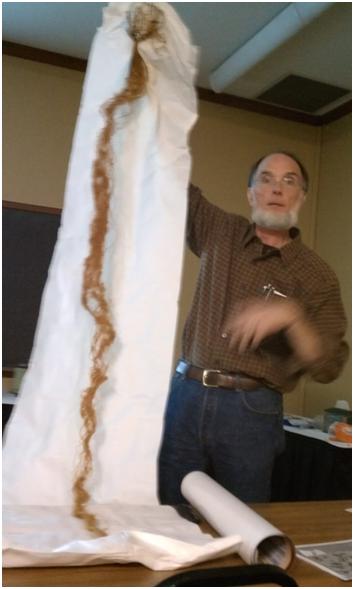
Alfalfa is one of the most important crops in the United States, due to its excellent quality, high yield, wide adaptation, disease resistance, excellent feeding quality, and soil benefits. It makes a tremendous contribution to Minnesota’s agricultural economy and to food production, but it often goes unrecognized. It’s like the restrained, subdued classmate beside the flashy, noticeable kids.
Indeed alfalfa made Minnesota’s dairy industry possible. Because of its superior protein content and very digestible fiber, it has often been used as feed for high producing dairy cows. In addition, it is fed to horses, sheep, and beef cattle because it is a good source of vitamins and minerals as well as protein. Alfalfa has a future as a basis for biofuel.
Alfalfa is an excellent crop to be planted in rotation with corn. Due to its nitrogen-fixing quality, alfalfa will replace nitrogen in the soil which the corn has withdrawn. Plus, it offers better carbon sequestration than soybeans. It improves soil structure, adding valuable organic matter to the soil. Alfalfa is a high yielding perennial plant that can withstand dry seasons and much of the plant is usable. In 2011 Minnesota farmers produced 4,070, 000 tons of alfalfa, harvesting 3.7 tons per acre. The harvested acreage that year was 1,100,000. Minnesota ranks 6th nationally in the production of alfalfa. Most of our alfalfa is grown for hay, but a small percentage is harvested for seed.
Jerry Fruin of the University of Minnesota’s Department of Applied Economics said that, “economical returns on alfalfa have been surpassed only by sugar beets in southwestern Minnesota for 25 years with returns generally superior to corn or soybeans.”
Why is Alfalfa Acreage Decreasing in Minnesota?
Despite its excellent value, acreage planted to alfalfa has been decreasing over the years. One major reason is that alfalfa receives no direct government subsidy. It must compete for economic viability with a wide mix of crops, many of them subsidized. For this reason prices for alfalfa seed can be costly.
Because of the high cost of alfalfa, some farmers are substituting other crops, such as straw and corn silage for their animals. Though such feed stuffs are cheap, this practice is a false economy. Studies show that alfalfa has a greater percentage of protein than grass hay. Animals fed alfalfa hay tend to gain faster and maintain themselves in better condition than otherwise fed. Also, dairy production is decreasing in the state. With fewer dairy farmers, there are fewer buyers for alfalfa hay.
How Alfalfa Came to Minnesota
In 1857 Wendelin Grimm and his family emigrated from Germany and settled in Carver County. A farmer, Grimm brought with him a small container of “ewiger Klee” (German for “everlasting clover”) or alfalfa seeds which had done well in his home country. The first winter most of the alfalfa was killed with Minnesota’s harsh conditions. Grimm collected seed from the surviving plants and planted them again. He continued this practice for a number of years, eventually creating a strain that could reliably survive the frigid winter. Grimm’s neighbors began to notice his success and asked for his seeds. In time this alfalfa made the Midwest dairy industry possible and became the basis for all varieties since.
In 1903 Grimm alfalfa was officially recognized by the U.S. Department of Agriculture and became the dominant strain. Grimm’s achievement has been cited as one of the most important breeding advances in the United States’ history.
The Grimm Farm in Carver County is maintained by the Three Rivers District Park. It is open to the public at specific times during the year.
Alfalfa and the Environment

Alfalfa gives the soil excellent benefits. Its deep-rooted character improves the soil structure and helps make it fertile without leaving too much nitrate run-off which could pollute water. Farmers are able to use alfalfa in crop rotation because it adds nitrogen to the soil, while many other crops deplete it.
Alfalfa helps prevent air pollution by controlling dust with its strong roots to hold the soil in place. Compared to soybean production, on 5% sloped ground alfalfa reduced soil erosion by 700 to 875%. The deep roots also allow alfalfa to be relatively drought tolerant. Compared to many other crops, alfalfa sprouts before all the others and grows longer than all the others. This allows the alfalfa to be harvested 4-6 times in a growing season, which is a much higher yield than most other crops that can only be harvested once.
Compared to other row crops, alfalfa has a low chemical impact. At times it requires herbicides and insecticides for optimal crop production, but the rate of pesticide use in alfalfa is lower than in many other crops. In addition, alfalfa offers excellent carbon sequestration.

Alfalfa has been used to mitigate several environmental problems, including absorbing nitrates from ground water, recycling dairy and municipal wastes, and mitigating industrial compounds that could contaminate groundwater. Alfalfa provides significant wildlife habitat for many species. It is a source of incredible insect diversity, including many beneficial ones.
At a train derailment site near Bordulac, North Dakota (pictured above), plant geneticist JoAnn Lamb and soil scientist Michael Russelle monitor the biological cleanup of nitrogen fertilizer with an unusual alfalfa. Yellowing leaves in the foreground indicate an area of cleaner soil because this unique strain of alfalfa cannot use bacteria to extract nitrogen from the air, and it depleted the nitrogen spilled in the soil.

Did You Know?
- Alfalfa has been used as an herbal medicine for over 1500 years.
- The scientific name for alfalfa is Medicago sativa.
- It is native to Asia Minor and the Caucasian Mountains.
- It was grown by the Persians, Greeks, and Romans.
- The Arabians called alfalfa “Father of All Foods” because they observed that it made their cattle stronger.
- Alfalfa was first introduced into North and South America by the Spanish Conquistadors in the 1500s to feed their horses.
- Alfalfa is known in many other parts of the world as Lucerne, Lucerne grass, Chilean clover, and buffalo grass.
- There are 79 million acres of cultivated alfalfa in the world, about 23 million in the U.S.
- It is a legume belonging to the pea family.
- It has a deep root system, sometimes stretching more than 49’.
- It is used in organic gardening as a fertilizer, since it adds value to the soil by its nitrogen fixing attributes.
For more information see the 10 Plants That Changed Minnesota MSHS book.